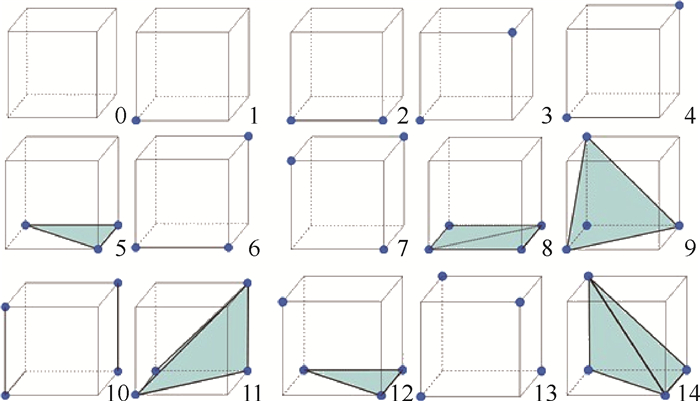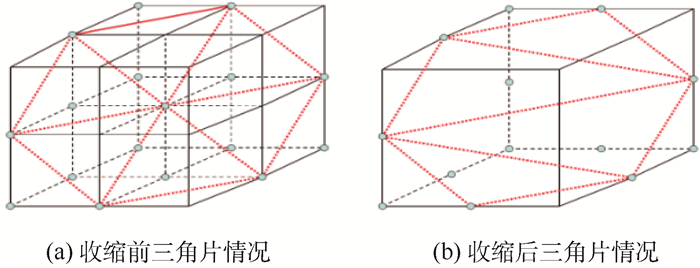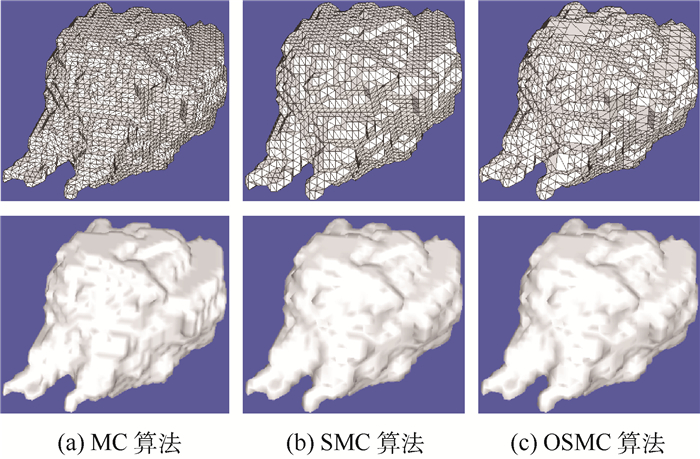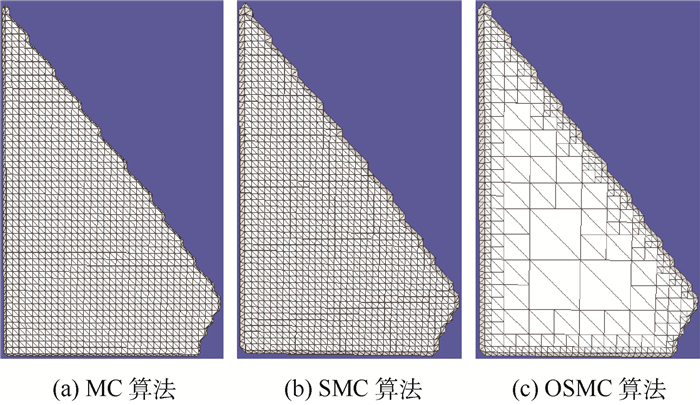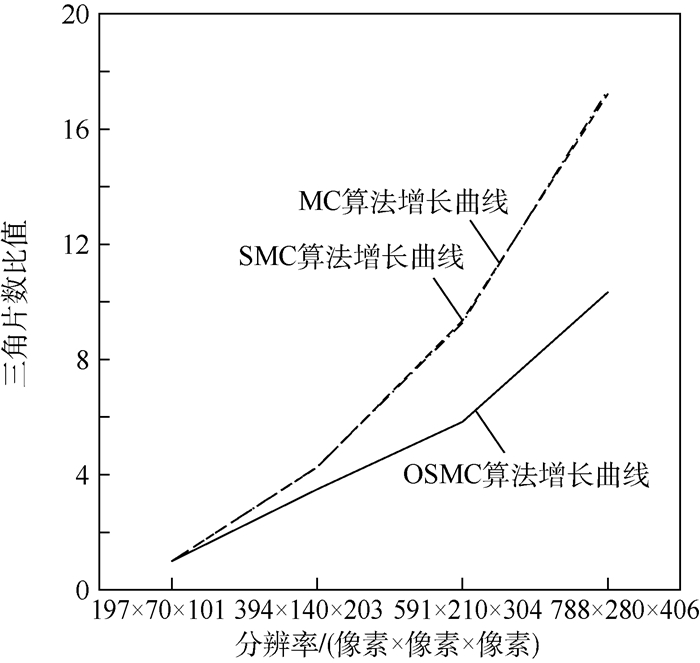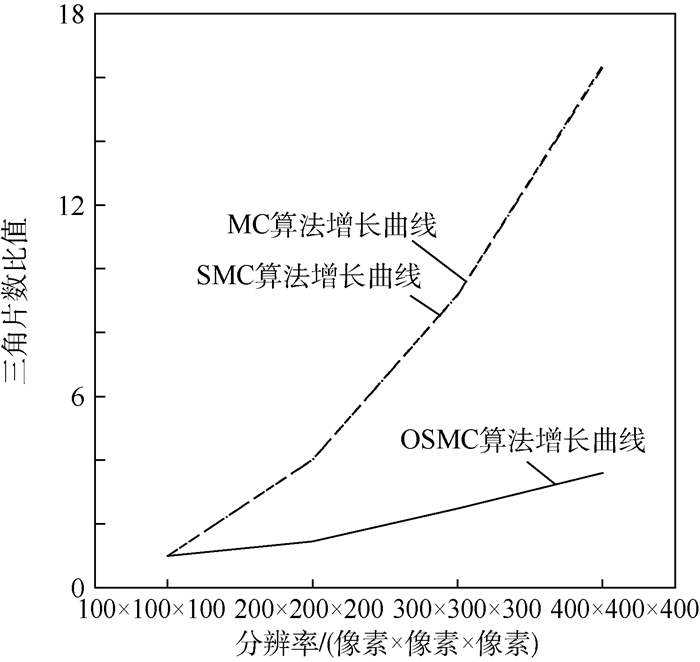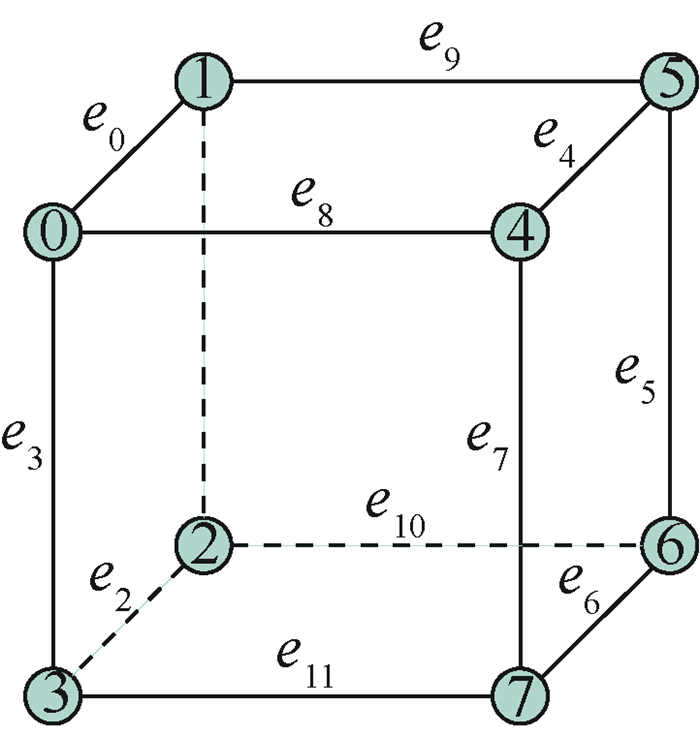Octree based decimation algorithm for triangle isosurface using simplified patterns
-
摘要:
采用简化构型的SMC算法相比标准MC算法能够有效减少构成等值面的三角片的数量,但因为其仅是在体元内部的简化,所以不能较好地利用数据集表面局部形态特征。针对这一问题进一步提出OSMC算法。其根据简化构型的特点,首先采用八叉树结构组织体元,然后采用自底向上的合并策略合并节点,最后实现局部区域三角片合并。实验证明:OSMC算法能够实现比SMC算法更多的三角片削减,尤其对于具有较多平坦区域的数据集效果显著,其对公开数据集数据的平均削减率为55.1%,而SMC算法为29.7%,在面对高分辨率的地质数据时其最高削减率达到了80%,平均也超过了50%,同时OSMC算法能够更好地适应数据集分辨率的增长。
Abstract:It is universally acknowledged that SMC based on simplified patterns extracts less triangles than the standard MC. Because only in-cube decimation was exploited, SMC is not able to take full advantage of local features of isosurfaces. Based on this observation, a new method named OSMC is presented in this paper. Based on characteristics of simplified configuration, OSMC first use octree structure to organize cells as nodes, then merge the nodes from bottom to top, and finally achieve local area triangles merging. The experimental results illustrate that the proposed method does further decimation than SMC, especially for datasets with large flat areas. The proposed method achieves an average reduction rate up to 55.1%, while the average reduction rate for SMC is 29.7%. The reduction rate reaches 80% at the highest and it is above 50% in average when OSMC is used on high-resolution geological dataset. Moreover, the new method is more adaptive to the increment of the dataset resolution.
-
Key words:
- isosurface /
- MC algorithm /
- SMC algorithm /
- octree /
- super cell
-
表 1 平面方程类型
Table 1. Types of plane equation
构型 三角片类型 平面方程类型 
正三角形 x+y+z=c x+y-z=c x-y-z=c x-y+z=c 
一般直角三角形 x+y=c x-y=c y+z=c y-z=c x+z=c x-z=c 
等腰直角三角形 x=c y=c z=c 表 2 部分数据集结果三角片数及削减率的对比
Table 2. Comparison between result of triangles numbers and reduction rate of part data set
数据集 三角片数 削减率/% MC算法 SMC算法 OSMC算法 OSMC较SMC算法 OSMC较MC算法 Engine 622764 432370 259479 -40.0 -58.3 Fan 508928 370256 179179 -51.6 -64.8 Table 475548 439692 90073 -79.5 -81.1 Teapot 745152 508798 304008 -40.2 -59.2 Bonsai 644340 435994 372986 -14.5 -42.1 Skull 1842404 1114208 1033229 -7.3 -43.9 Backpack 3985836 2876044 2066527 -28.1 -48.2 Phantom 7457316 5296868 3557633 -32.8 -52.3 Lobster 1245556 721914 632738 -12.4 -49.2 表 3 人体肺部结节数据结果三角片数及削减率的对比
Table 3. Comparison between result of triangle numbers and reduction rate of human pulmonary nodules data set
数据集 三角片数 削减率/% MC算法 SMC算法 OSMC算法 OSMC较SMC算法 OSMC较MC算法 肺部结节1 11652 7524 6498 -13.64 -44.23 肺部结节2 1992 1366 1160 -15.08 -41.77 肺部结节3 3704 2564 2012 -21.53 -45.68 肺部结节4 17360 10744 9198 -14.39 -47.02 肺部结节5 16212 10098 8623 -14.61 -46.81 肺部结节6 25052 16258 13583 -16.45 -45.78 肺部结节7 44344 25638 24213 -5.56 -45.40 肺部结节8 19972 11714 11350 -3.11 -43.17 总计 -10.80 -45.37 表 4 地质体数据结果三角片数及削减率的对比
Table 4. Comparison between result of triangle numbers and reduction rate of geological data set
数据集 三角片数 削减率/% MC算法 SMC算法 OSMC算法 OSMC较SMC算法 OSMC较MC算法 地质体1 4216160 3068372 1569472 -48.85 -62.77 地质体2 3570748 3044366 1123834 -63.09 -68.53 地质体3 3998268 3018910 1068565 -64.60 -73.27 地质体4 7187412 5691550 1902811 -66.57 -73.53 地质体5 2374620 1788710 764733 -57.28 -67.80 地质体6 3348048 2714290 639024 -76.46 -80.91 地质体7 33408 26202 14492 -44.70 -56.62 总计 -63.40 -71.35 表 5 Table数据集4种分辨率下实验结果
Table 5. Results under four resolutions for Table data set
分辨率/(像素×像素×像素) MC算法 SMC算法 OSMC算法 三角片数 与1倍分辨率比值 三角片数 与1倍分辨率比值 三角片数 与1倍分辨率比值 197×70×101 111652 1.00 103056 1.00 7028 1.00 394×140×203 475548 4.26 439692 4.27 10196 3.49 591×210×304 1045120 9.36 955408 9.27 17464 5.84 788×280×406 1920724 17.20 1786762 17.34 25334 10.33 表 6 四面体数据集4种分辨率下实验结果
Table 6. Experimental results under four resolutions for tetrahedral data set
分辨率/(像素×像素×像素) MC算法 SMC算法 OSMC算法 三角片数 与1倍分辨率比值 三角片数 与1倍分辨率比值 三角片数 与1倍分辨率比值 100×100×100 55868 1.00 37438 1.00 7028 1.00 200×200×200 224648 4.02 150152 4.01 10196 1.45 300×300×300 513332 9.19 343384 9.17 17464 2.48 400×400×400 914936 16.38 610738 16.31 25334 3.60 -
[1] LORENSEN W E, CLINE H E. Marching cubes: A high resolution 3D surface construction algorithm[C]//ACM Siggraph Computer Graphics. New York: ACM, 1987, 21(4): 163-169. [2] HEIMBACH I, RHIEM F, BEULE F, et al.pyMolDyn:Identification, structure, and properties of cavities/vacancies in condensed matter and molecules[J].Journal of Computational Chemistry, 2017, 38(6):389-394. doi: 10.1002/jcc.24697 [3] YIM P J, VASBINDER G B C, HO V B, et al.Isosurfaces as deformable models for magnetic resonance angiography[J].IEEE Transactions on Medical Imaging, 2003, 22(7):875-881. doi: 10.1109/TMI.2003.815056 [4] BRONSON J R, SASTRY S P, LEVINE J A, et al.Adaptive and unstructured mesh cleaving[J].Procedia Engineering, 2014, 82:266-278. doi: 10.1016/j.proeng.2014.10.389 [5] FERLEY E, CANI M P, GASCUEL J D.Practical volumetric sculpting[J].The Visual Computer, 2000, 16(8):469-480. doi: 10.1007/PL00007216 [6] STEIN R, SHIH A M, BAKER M P, et al. Scientific visualization of water quality in the Chesapeake bay[C]//IEEE Visualization Conference. Piscataway, NJ: IEEE Press, 2000: 509-512. [7] TREMBILSKI A.Two methods for cloud visualisation from weather simulation data[J].The Visual Computer, 2001, 17(3):179-184. doi: 10.1007/PL00013405 [8] KIM K, WITTENBRINK C M, PANG A. Data level comparison of surface classification and gradient filters[C]//Volume Graphics 2001. Berlin: Springer, 2001: 19-34. [9] NIELSON G M, HAMANN B. The asymptotic decider: Resolving the ambiguity in marching cubes[C]//Proceedings of the 2nd Conference on Visualization'91. Piscataway, NJ: IEEE Press, 1991: 83-91. [10] RECK F, DACHSBACHER C, GROSSO R, et al. Realtime iso-surface extraction with graphics hardware[C]//Eurographics. Geneva: Eurographics, 2004: 1-4. [11] JOHANSSON G, CARR H. Accelerating marching cubes with graphics hardware[C]//Proceedings of the 2006 Conference of the Center for Advanced Studies on Collaborative Research. Armonk: IBM Corporation, 2006, 6: 39. [12] NEWMAN T S, YI H.A survey of the marching cubes algorithm[J].Computers & Graphics, 2006, 30(5):854-879. [13] SCHROEDER W J, ZARGE J A, LORENSEN W E. Decimation of triangle meshes[C]//ACM Siggraph Computer Graphics. New York: ACM, 1992, 26(2): 65-70. [14] GARLAND M, HECKBERT P S. Surface simplification using quadric error metrics[C]//Proceedings of the 24th Annual Conference on Computer Graphics and Interactive Techniques. New York: ACM Press/Addison-Wesley Publishing Co., 1997: 209-216. [15] MONTANI C, SCATENI R, SCOPIGNO R. Discretized marching cubes[C]//Proceedings of the Conference on Visualization'94. Piscataway, NJ: IEEE Press, 1994: 281-287. [16] MONTANI C, SCATENI R, SCOPIGNO R.Decreasing isosurface complexity via discrete fitting[J].Computer Aided Geometric Design, 2000, 17(3):207-232. [17] SHU R, ZHOU C, KANKANHALLI M S.Adaptive marching cubes[J].The Visual Computer, 1995, 11(4):202-217. doi: 10.1007/BF01901516 [18] SHEKHAR R, FAYYAD E, YAGEL R, et al. Octree-based decimation of marching cubes surfaces[C]//7th Annual IEEE Conference on Visualization. Piscataway, NJ: IEEE Press, 1996: 335-342. [19] OHTAKE Y, BELYAEV A, ALEXA M, et al. Multi-level partition of unity implicits[C]//ACM Siggraph 2005 Courses. New York: ACM, 2005: 173. [20] KAZHDAN M, HOPPE H.Screened poisson surface reconstruction[J].ACM Transactions on Graphics (TOG), 2013, 32(3):29. [21] WILHELMS J, VAN GELDER A.Octrees for faster isosurface generation[J].ACM Transactions on Graphics (TOG), 1992, 11(3):201-227. doi: 10.1145/130881.130882 [22] WESTERMANN R, KOBBELT L, ERTL T.Real-time exploration of regular volume data by adaptive reconstruction of isosurfaces[J].The Visual Computer, 1999, 15(2):100-111. [23] CUI S H, LIU J.Simplified patterns for extracting the isosurfaces of solid objects[J].Image and Vision Computing, 2008, 26(2):174-186. doi: 10.1016/j.imavis.2007.02.003 [24] VIGNOLES G L, DONIAS M, MULAT C, et al.Simplified marching cubes:An efficient discretization scheme for simulations of deposition/ablation in complex media[J].Computational Materials Science, 2011, 50(3):893-902. doi: 10.1016/j.commatsci.2010.10.027 -







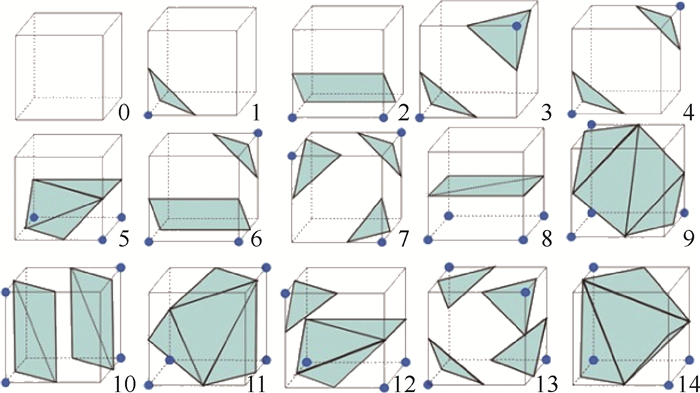
 下载:
下载:
